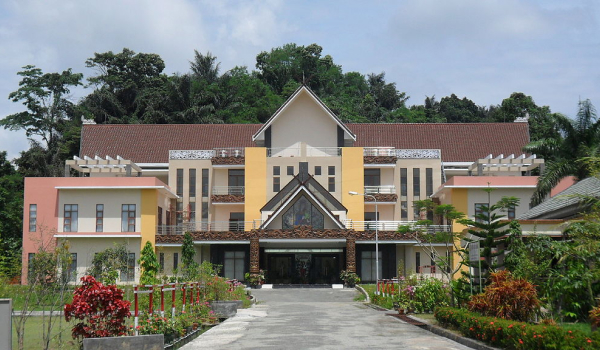
In a land area of 211,440 square kilometers, the archdiocese of Samarinda is located in eastern part of Kalimantan, Indonesia's southern territory of Borneo Island. The archdiocese's geographical territory covers Samarinda, Balikpapan, and Bontang Cities, and West Kutai, Kutai Kartanegara, East Kutai , Pasir, Penajam, and North Paser districts.
In socio-cultural context, local people, including Catholics, have their own traditions and languages. They are: Tidung, Banjar, Berau, Kutai, and Lundayeh. However, their encounter can be easier thanks to the national language of Bahasa Indonesia.
The history of the mission of Catholic Church in East Kalimantan began in 1907, when Capuchin missioners started to serve in Laham village located along the banks of Mahakam river, about 500 kilometers from Samarinda. On March 21, 1907, the first three missioners - Fathers Libertus Cluts and Camilus Buil and Brother Ivo - were sent from Pontianak, in West Kalimantan, to East Kalimantan in order to serve here. After going through a long trip from Pontianak to Jakarta and Surabaya, they arrived in Samarinda on April 24, 1907. They later went to Long Iram village. After staying here for two months, they went to Laham village on June 26, 1907, and arrived there two days later. At the beginning, they stayed for a year at a temporary shelter usually used by traders and militaries. Afterward, they stayed at a simple parish house.
On Jan. 6, 1913, the first baptism for 14 boys was organized. And on July 29 in the same year, 21 girls were baptized. The first Catholic wedding ceremony was held on Oct. 6, 1925. But five years earlier, or in 1920, Franciscan nuns from Veghel, the Netherlands, came to help the Capuchin missioners.
Due to a difficult communication between Laham village and Pontianak and a lack of manpower to evangelize in West and East Kalimantan, Capuchin provincial in the Netherlands wrote Holy Family provincial on Aug. 18, 1924, asking Holy Family Society to take over the pastoral service in East Kalimantan. Holy Family provincial accepted it and even wanted to serve not only in East Kalimantan but also in South and Central Kalimantan.
On Jan. 1, 1926, the first three Holy Family missioners - Fathers F. Groot and J. Vander Linden and Brother Egidius Stoffles - left Amsterdam for East Kalimantan. Since 1926, the Holy Family Society officially took over and continued the evangelization started by the Capuchin missioners. New missioners were sent in: two missioners in 1927, three missioners in 1928, and another three missioners in 1929. The first place they chose as a mission station was Tering village.
In 1928, a priest and a brother were sent in so as to establish a parish house and a church. The first years were a difficult time because they had no enough experience and faced challenges like infectious diseases.
On May 21, 1938, the ecclesiastical areas of Central, South and East Kalimantan were separated from Pontianak and became the apostolic prefect of Banjarmasin.
When the Second World War broke out, Tarakan Island was assailed by Japan on Jan. 11, 1942, which then led to the capture of priests, including those from Balikpapan.
During Japanese occupation, some priests were killed together with other Dutch people. When the Japanese authority expelled many missionaries, several lay leaders emerged in some places who played a significant role in maintaining people's faith.
Prior to Indonesian independence in 1945, the condition of East Kalimantan started to improve, which enabled missionaries to continue their mission, including the development of Tering.
Since 1948, two MASF nuns - Sister Yosefa and Sister Bernarda - started a community in Balikpapan, and in 1949 four MASF sisters started Tering mission, taking over the role of Franciscan Sisters who rejoined their colleagues in West Kalimantan after Japanese occupation.
On Feb. 21, 1955 petition was sent to Rome for the expansion of the vicariate. Then apostolic vicariate of Samarinda was established.
Since that time, under the leadership of Bishop Michael Cornelis C. Coomans, MSF, mission center was relocated from Tering to Samarinda, covering the areas of East Kalimantan, but excluding Balikpapan which joined Samarinda diocese in 1966.
When Samarinda became apostolic vicariate, there were 4,955 Catholics, 23 pastors and 4 religious brothers. Its condition at that time as mission center lagged behind Banjarmasin and Balikpapan. At that time there was only one church building, small and made of wood. The building and the rectory were almost collapsed.
Since Jan. 3, 1961, the status was elevated from apostolic vicariate to diocese of Samarinda.
In 1963, Dutch pastors were asked to leave hinterland missions. However, several lay leaders petitioned the local and central government to review such policy. They succeeded and in 1965, missionaries returned to their parishes in remote areas.
In 2002, Rome approved the establishment of Tanjung Selor diocese, and Bishop Yustinus Harjosusanto MSF was assigned the ordinary overseeing the northern territory of East Kalimantan province.
In economic context, this province is rich in natural resources such as oil, natural gas, and coal. Other sectors which are developing are agriculture, tourism, and manufactural industries. East Kalimantan is the richest province in Indonesia and has a GDP equivalent per Capita of $9,000 (as of June 2009), while the national per capita income is equivalent of $3,900.